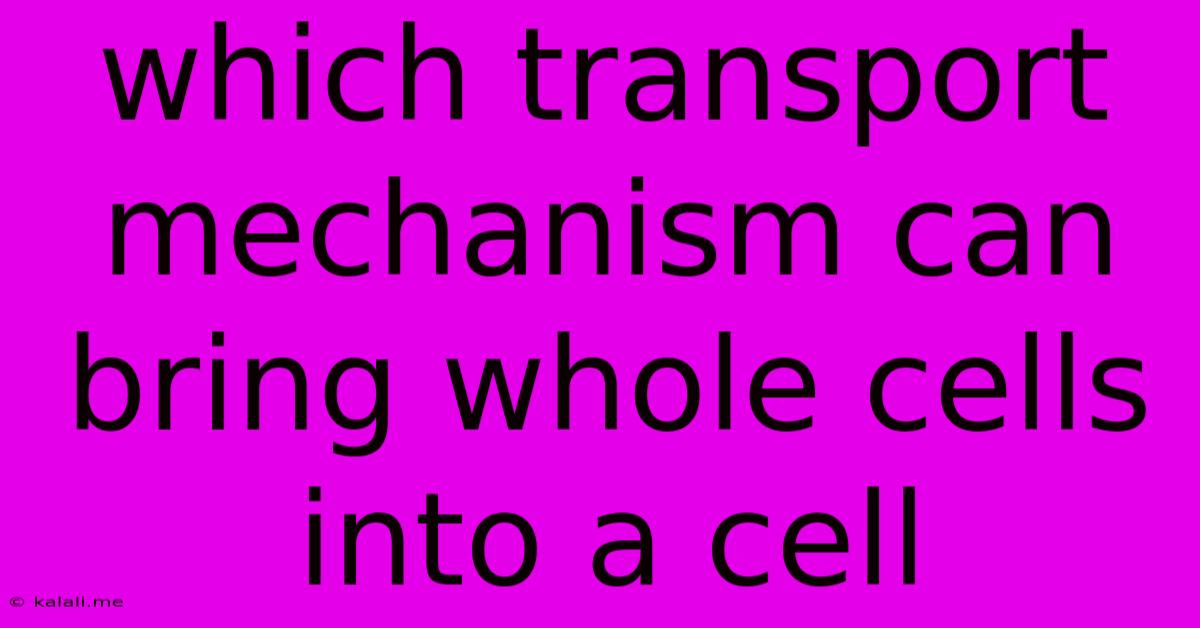Which Transport Mechanism Can Bring Whole Cells Into A Cell
Kalali
May 10, 2025 · 3 min read

Table of Contents
Which Transport Mechanism Can Bring Whole Cells into a Cell? A Deep Dive into Phagocytosis
The question of how whole cells can be brought into another cell is a fascinating one, delving into the intricacies of cellular processes. While many transport mechanisms facilitate the movement of molecules and smaller particles across cell membranes, only a specific type can engulf and internalize entire cells: phagocytosis. This article will explore phagocytosis in detail, explaining its mechanism, significance, and related cellular processes.
Phagocytosis, meaning "cell eating," is a crucial process in both the innate and adaptive immune systems. It's a form of endocytosis, a process where cells absorb material from their surroundings by engulfing it. Unlike other endocytic processes like pinocytosis (cellular drinking) which takes in fluids and dissolved substances, or receptor-mediated endocytosis which targets specific molecules, phagocytosis specifically targets larger particles, including entire cells, cellular debris, and pathogens.
The Mechanics of Phagocytosis: A Step-by-Step Guide
The process of phagocytosis is a complex, multi-step procedure involving several cellular components and signaling pathways. Here's a breakdown of the key stages:
-
Chemotaxis: The phagocytic cell, often a macrophage, neutrophil, or dendritic cell, is attracted to the target cell or particle through chemotactic signals. These signals can be released by the target itself or by other immune cells. Think of it as the phagocyte "sensing" its prey. Examples of chemoattractants include bacterial components like lipopolysaccharide (LPS) and complement proteins.
-
Recognition and Attachment: Once close to the target, the phagocyte recognizes and attaches to it. This recognition often involves specific receptors on the phagocyte's surface binding to molecules on the target cell's membrane, such as antibodies or complement proteins. This binding initiates the engulfment process.
-
Engulfment (Ingestion): The phagocyte extends pseudopods, membrane protrusions, around the target cell. These pseudopods eventually fuse, enclosing the target within a newly formed intracellular vesicle called a phagosome. This is essentially the "eating" phase, where the whole cell is enclosed within the phagocyte.
-
Phagosome-Lysosome Fusion: The phagosome then fuses with lysosomes, which are organelles containing a variety of digestive enzymes. This fusion creates a phagolysosome.
-
Digestion and Degradation: The enzymes within the phagolysosome break down the ingested cell, including its proteins, nucleic acids, and other components.
-
Exocytosis: The indigestible remnants of the degraded cell are expelled from the phagocyte through exocytosis, a process that involves the fusion of the phagolysosome with the cell membrane.
The Importance of Phagocytosis: Beyond Immune Defense
While crucial for immune defense against pathogens like bacteria and viruses, phagocytosis also plays other vital roles:
- Apoptosis Removal: Phagocytes clear apoptotic cells (cells undergoing programmed cell death) preventing inflammation and maintaining tissue homeostasis.
- Wound Healing: Phagocytosis helps to remove cellular debris from injured tissues, promoting healing.
- Developmental Processes: Phagocytosis plays a role in various developmental processes, such as the removal of excess cells during development.
Related Processes and Distinctions
It's important to distinguish phagocytosis from other cellular processes:
- Pinocytosis: Cellular drinking, involves the uptake of fluids and small molecules.
- Receptor-mediated endocytosis: A highly selective process targeting specific molecules bound to receptors on the cell surface.
- Macropinocytosis: A form of endocytosis that involves the uptake of large volumes of extracellular fluid and large particles.
In conclusion, phagocytosis is the unique transport mechanism capable of bringing whole cells into a cell. This complex and crucial process is fundamental to immune function, tissue homeostasis, and various developmental processes. Understanding its intricacies is key to appreciating the dynamic nature of cellular interactions and the body's intricate defense mechanisms.
Latest Posts
Latest Posts
-
What Is The Easter Bunny Favorite Color
Jun 30, 2025
-
How Much Is 100 Gallons Of Diesel
Jun 30, 2025
-
How Much Is 50 Gallons Of Water
Jun 30, 2025
-
How Many Laps Around A Football Field Is A Mile
Jun 30, 2025
-
The Ability To Say Clever And Funny Things
Jun 30, 2025
Related Post
Thank you for visiting our website which covers about Which Transport Mechanism Can Bring Whole Cells Into A Cell . We hope the information provided has been useful to you. Feel free to contact us if you have any questions or need further assistance. See you next time and don't miss to bookmark.